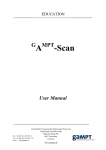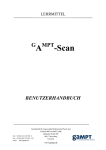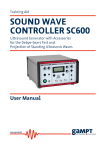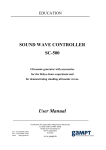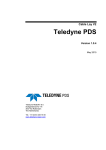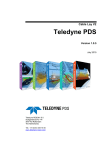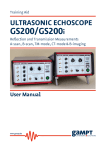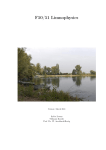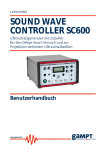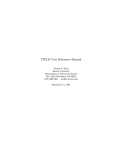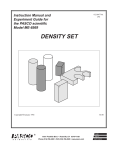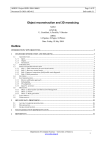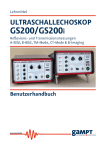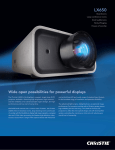Download Flow-Dop - GAMPT mbH
Transcript
EDUCATION Pulse Doppler Flow-Dop GAMPT-50100 User Manual Gesellschaft für Angewandte Medizinische Physik und Technik mbH (GAMPT mbH) Hallesche Straße 99F 06217 Merseburg Fon: +49 (0) 3461-278 691- 0 Germany Fax: +49 (0) 3461-278 691- 101 email: [email protected] www.gampt.de Revision 1.1: March 2007 with software version 1.2 Revision 1.2: February 2008 with software version 1.3 Revision 2.0: February 2009 with software version 1.3 (with selectable frequencies 1, 2 ,4 MHz) All rights are reserved by the GAMPT mbH. No part of this manual may be copied, reproduced, translated or transmitted in any form without permission of the GAMPT mbH. The GAMPT mbH does not assume responsibility for damages as a result of false use as well as repair and changes which are carried out from third not authorized by the GAMPT mbH. Technical and software changes reserved. Errors and omissions excepted. Copyright © GAMPT mbH Hallesche Straße 99F • 06217 Merseburg • Germany Phone +49 (0) 3461/278 691 0 • Fax +49 (0) 3461/278 691 101 [email protected] • www.gampt.de Contents 1. Introduction 4 2. Components 5 2.1. Flow-Dop GAMPT-50100 Front Panel 5 2.2. Flow-Dop GAMPT-50100 Rear Panel 6 2.3. Ultrasonic Probe (standard) GAMPT-10131/10132/10134 7 2.4. Ultrasonic Probe for the Arm Dummy GAMPT-50135 7 Software 8 3.1. Introduction 8 3.2. Main Window 8 3.3. Data Transfer 9 3.4. Parameter 10 3.5. Start a Measurement 11 3.6. Additional Windows 12 Technical Details 13 4.1. Power Supply 13 4.2. Measurement Range / Resolution 13 4.3. Display 13 4.4. Software 13 4.5. Cleaning 13 3. 4. Introduction 1. Introduction The pulse Doppler device generates pulses of transmission with a selectable frequency of 1, 2 or 4 MHz, which are sent as ultrasonic waves by a connected transducer. If these waves are scattered or reflected at moved particles or bubbles they suffer a frequency shift (Doppler effect). The device registers and evaluates these scattered waves. An audio signal is created. The audible volume is a measure of the amplitude of the reflected signal, the frequency is a measure of the speed of the scattered particles. Simultaneously the amplitude is indicated as a deflection of a LED bar. Moreover the device can pass on the measured data to a PC in order to perform records and evaluations in detail. Sensitivity and volume can be adjusted at the device by means of control knobs. By means of the supplied software “FlowView“, the data measured by the device can be evaluated on a PC/laptop. The connection of the device is realized via a parallel port interface (LPT) or an USB interface. During the measurement the software shows the current Doppler signal. The evaluation uses a transformation into the frequency space by means of a Fourier-transformation. In this way the most frequently occurring or the highest occurring frequencies are determined which are a measure of the speed in the stream. These frequencies and the velocities and flow values calculated of these data are displayed on the screen as values or as time curves, respectively. Additionally, the energy content of the signal is displayed. Further evaluation functions are the representation of the spectrum with colour-coded intensities over the time range or the examination of the pulsatility of the flow. By varying the sample volumes information from different layers of the stream can be obtained. In that way the velocity and concentration profiles can be built. 4 Components 2. Components 2.1. Flow-Dop GAMPT-50100 Front Panel Figure 1: Front panel with control and display components Use the power button (8) to switch on the device. The switch lights up green when the device is on. With the switch (1) the gain of the received Doppler signal can be adjusted. There are four gain steps 10dB, 20dB, 30dB and 40dB with a maximum difference of 30dB or 31-times magnification. The two switches of the area “SAMPLE VOLUME” are designed for the adjustment of the measurement region. The “POWER” switch (2) varies the transmitter burst length between 2µs “LOW” and 4µs “HIGH”. With the switch “SAMPLE VOL.” (3) the receiver gate can be switched between 2µs “SMALL” and “LARGE” (full range = 32µs). With the turning knob (4) the volume of the Doppler signal audio output with the built-in speaker can be adjusted. The audio signal serves only for orientation and control purposes during the measurement because its amplitude depends on the frequency and might falsify the Doppler frequency. The measuring probes are connected at the socket (5). The same socket will be used in the GAMPT A-Scan echoscope. Therefore, the standard probes (1, 2 or 4 MHz) of the echoscope experiments can also be used for the Doppler experiments. The light bar (6) shows the amplitude of the current Doppler signal. The display serves only for a rough orientation. Exact results can only be obtained by the software. The multiple switch (7) has 32 positions to vary the time position of the receiver gate. This switch has only a function with the “SAMPLE VOL.” switch in position “SMALL”. The minimum time position of the gate is 4 µs. That is equivalent to a distance between probe and measurement volume of 6mm in water or a depth of 10mm in acryl. The position can be varied in steps of 0,5µs up to a maximum distance of 19,5µs or 30mm in 5 Components water or 50mm in acryl. So one can measure the frequency (velocity) distribution in a tube by varying the position of the sample volume inside the tube. Use the smallest possible sample volume with the “POWER” switch in position “LOW” and the “SAMPLE VOL.” switch in position “SMALL”. With the switch (9) the transmitted ultrasonic frequency can be selected. The frequency selection switch has 3 settings 1, 2 and 4 MHz. To obtain a Doppler signal the frequency of the used ultrasonic probe must correspond with the frequency selection switch setting. 2.2. Flow-Dop GAMPT-50100 Rear Panel Figure 2: rear panel with connectors (left parallel port, right USB port) Attach the power cable to the power socket on the left side of the rear panel. The fuse is located in the power socket. Notice! Please follow the voltage and power specifications on the device! Connect the data cable to the parallel port or USB port of the device on the right side of the rear panel and the parallel interface or USB interface of the computer. Use a DB25M-M cable (25 pole, male, male) or an USB device cable. 6 Components 2.3. Ultrasonic Probe (standard) GAMPT-10131/10132/10134 The standard probes are suitable for wide range employment. Because of the higher frequency the axial and lateral resolution power is evidently better for 2 and 4 MHz probes compared to the 1 MHz probes. On the other hand the damping of 2 MHz compared to the 4 MHz sound in most materials is not yet too large, so that investigations in middle depth can be obtained easily. With the different probes it is possible to show the dependence of the Doppler shift on the transmitter frequency. Technical specification: Frequency: 1, 2, 4 MHz Size: l= 70mm, d= 27mm, cable 1m Sound adaptation to water/acrylic Special plug connector with probe identification for connection to GAMPT-Scan or universal plug connector BNC To obtain a Doppler signal the frequency of the used ultrasonic probe must correspond with the frequency selection switch setting (1 MHz=GAMPT-10131 blue, 2 MHz =GAMPT-10132 red, 4 MHz=GAMPT-10134 green) 2.4. Ultrasonic Probe for the Arm Dummy GAMPT-50135 The ultrasonic Doppler probe with a frequency of 2 MHz is especially designed for measurements with the arm dummy. The pencil form and the small probe area result in a good handling and an adequate local resolution. The delay line with a determined angle of 30° is responsible for a constant Doppler angle and a significant Doppler frequency shift. So a quantitative analysis to determine the flow velocity is possible. Technical specification: Frequency: 2 MHz Size: l= 200mm, d= 15mm, cable 1m, Special plug connector for connection to FlowDop Delay line: angle: 30°; sound velocity: 2700m/s To obtain a Doppler signal the selection switch setting must be 2 MHz. 7 Software 3. Software The software is complemented and updated constantly. For the newest update, please contact the company GAMPT mbH at [email protected]. In the following documentation the software FlowView in the version number 1.3 is described. Other versions can show some deviations. 3.1. Introduction The software FlowView is a measuring program for the Flow Doppler. Before starting the program connect the Flow Doppler device to the PC via the parallel port LPT (optional you can use the USB adapter). The program has a simulation mode. When there is no connection to the device or the device is switched off, the program will go automatically into this simulation mode. To leave the simulation mode you have to establish a data connection (see also chapter “Data Transfer”) 3.2. Main Window After starting the program the main window appears. The main window will always be aligned to the top of the screen. The window can be resized by moving the bottom window border. This can be helpful when additional windows are shown. The menu line and the button panel at the top serve to start the measurements, select different parameters or show additional windows. The two diagrams show the current values during the measurement. In the bottom lines current parameters and results are shown. Before starting a measurement some parameters are needed. Selecting parameter will open a window to feed in these values (see chapter Parameter). The start button begins a measurement. The button export jpg is enabled during and after a measurement. It can be used to save the actual shown windows as jpg-images. After pressing the button a dialog will ask for the filename. With exit the program will end. The text beside the exit button shows the current status of data transfer. When the text is red, the simulation mode is active, otherwise the text is green. With a mouse click on this text (only available when no measurement is running) or the menu item preference / data transfer the data transfer can be changed. 8 Software 3.3. Data Transfer By selection of the menu item preference/ data transfer in the main window the data transfer window will open. The FlowDop can be connected via parallel port (LPT 1-4) or using the USB adapter. Please select at first the type of data connection. Pressing the refresh button will try to establish a connection. When there is a problem with it you get a red message in the bottom window part. The program will switch to simulation mode and stay there until a correct connection can be realized. In the message you get a hint of the probable reason for the problem. When you selected the LPT mode, you have the choice between the EPP or non EPP mode. The EPP mode has a better performance (faster data transfer), but not all PC (especially notebooks) can support this mode. Then you have to select the non EPP mode. Before using the USB connection the adapter driver has to be installed. For this insert the delivered CD, connect the USB adapter to an USB port and follow the instructions. When the connection was checked and no problems occur, you get the information as green text in the bottom line. By pressing Close the program goes back to the main window and you can start a measurement. The information text in the main window is now green and shows you the selected transfer type (LPT or USB). The program stores the selected transfer type and checks it each time you start the program and before a measurement. In case of a problem (i.e. the device is off or cable not connected) the program switches to simulation mode. You get a message window. In this case you have to restart the program or check again the connection in the data transfer window. 9 Software 3.4. Parameter To calculate speed and flow from the frequency value we need some parameters. These are the Doppler angle and the cross section of the used tube or pipe. The Doppler angle depends in first line on the incident angle of the sound beam. In reason of the law of refraction the incident angle is not the Doppler angle. To calculate the Doppler angle we need the sound velocities of the involved materials. The first material is the acrylic Doppler prism (cacrylic= 2700m/s). The other one is the used liquid (here: water, cwater= 1480m/s). The Doppler prism allows three incident angles, you can change it with the preselection. When other materials or delay lines are used the parameters have to be adapted. With help of the incident angle and the given sound velocities the Doppler angle can be calculated. Together with the Doppler equation we can calculate the speed from the estimated frequency. Knowing the speed we can calculate the flow. For this we need the cross section of the tube. To calculate it out of the diameter of the tube or pipe we assume a circular cross section. The signal intensity is a measure of the energy in the back scattered signal. It is calculated as the mean of squares of the signal values. A small integral value shows that there are less or small scatterer in the sample volume. To avoid error measures there is a lower limit for the intensity. When the measured intensity is less than this limit the program assumes there are no moving scattering particles and stops further calculation. Maybe you have to adapt the lower limit value for special measurements, like profile measurements with small sample volume. When changing the used incident angle or tube the user has to tell it the program. Otherwise the calculated values for speed and flow are wrong. You can change the parameters during a measurement. 10 Software 3.5. Start a Measurement A measurement will be started with the start button. Then the following picture will be shown. The start button changes to stop , with it the measurement can be finished. With the break button on the right side the measurement can be interrupted, break will change to continue. It is not possible to exit the program during a measurement. In the left diagram we see the current signal values changing over the time. The scale of this diagram is fixed to 0.5V per division. To adapt the amplitude in the diagram you have to use the amplifier knob (“GAIN”) at the front panel of the device. In the right diagram we see the Doppler spectrum of the signal. The vertical black line describes the zero value, there are also positive and negative frequency values possible. Generally the sign describes the flow direction in the tube. A negative frequency value means the flow goes to the opposite direction (or the ultrasonic probe has turned around). This meaning of negative values is also valid for the derived measures like speed and flow. The arrows beside and below serve to scale the diagram. It is possible to zoom in or zoom out with it. The double one makes an auto scale which means that the diagram is self scaling to maximum values. In the Doppler spectrum we estimate two values, f-max and f-mean. f-max is the highest occurring frequency in the spectrum over the noise level. This frequency represents the fastest particle in the flow (green line). f-mean represents the centre of the occurring frequencies (blue line). The estimated results are shown in the bottom result lines. The program measures up to 12 values per second for f-mean and f-max. All these values will be shown in the additional windows (see below). In the bottom result lines we work with average values. Outgoing from f-mean the speed and flow values are calculated. The standard deviation gives the statistical error for the average and is valid for f-mean and all derived measures. When there is a pulsatile flow the statistical error will strongly increase, depending on the frequency change during the averaging interval. The ratio f-max / f-mean can be helpful to describe the flow. Laminar flow profiles have another ratio than turbulent flows. The signal intensity is a measure of the energy in the back scattered signal. When the signal intensity is less than the lower limit further frequency calculation is stopped (see chapter Parameter). The shown value will be red. Keep in mind, that the intensity value is calculated from the signal values shown in the left diagram and these depend on the adjusting of the gain. The resistance index RI should help to describe the resistance in a pulsatile circulation (for more detailed information see also 3.5 “10 sec section”). 11 Software 3.6. Additional Windows Depending on the windows selection in the upper main window, additional windows in the bottom part of the screen can appear. The first of them is the time course window. Here we see the Doppler spectrum grey or colour scaled. The frequencies are shown in y-direction, the amplitude of the frequencies in the spectrum are colour scaled. The x-axis represents a time section. The diagram shows always the last seconds of a measurement, in the picture beside this are 10 sec. The length of the time section can be changed by using the arrows below. The colour values can be changed in the upper area. Thereby the slider works similar to the level/width window technique well known from different medical applications like computer tomography. The special values f-max and fmean are distinguished in own colour values. In the “10 sec section” we see always the last 10 sec of a measurement. The values for f-max and f-mean are shown separately. Here we can also explain the resistance index RI. It is defined as (Pourcelot): v − vD RI = S vS with vS as highest speed during systole and vD as end diastolic minimum value. In the diagram we can estimate equivalent frequency values for vS and vD (see brown horizontal line). The resistance index can be calculated. Keep in mind that the resistance index makes only sense in a pulsatile circuit. When there is a pulsatile flow the pulse frequency can be estimated. For this we calculate the spectrum of the “10 sec section “. When there is a ‘stable’ pulsatile flow we get a peak with the searched pulse frequency. (When there is no pulsatile flow a pulse calculation and the appearance of this window make no sense) 12 Technical Details 4. Technical Details 4.1. Power Supply Power supply: Fuse: 4.2. 230V / 50Hz 115V / 60Hz T250mA / 250V T500mA / 250V Measurement Range / Resolution Gain : Transmitter power: Sample volume: 4.3. (Europe) (USA) (Europe) (USA) 10dB, 20dB, 30dB, 40dB Low (2µs Burst), High (4µs Burst) Small (2µs receiver gate), Large (Full receiver gate ca. 32µs) Display optical display of Doppler signal amplitude Acoustical Doppler signal 4.4. Software FlowView with driver for communication via parallel interface for Win9x, Me, WinNT, 2000, XP (optional via USB adapter) 4.5. Cleaning Do not clean sensors with sharp detergents, do not dip into water. Clean the control unit only with a damp cloth. 13













